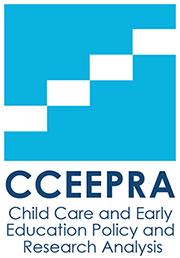Child Care and Early Education Policy and Research Analysis (CCEEPRA)
Principal Investigators: Tamara Halle, Kathryn Tout
Funded by: OPRE, with research set aside funds from the CCDBG Act of 2014
Federal Project Officer: Ivelisse Martinez Beck
 The purpose of the Child Care and Early Education Policy and Research Analysis (CCEEPRA) project is to support policy and program planning and decision-making with rigorous, research-based information gained through data collection, analysis and consultation from experts in early care and education (ECE). Through CCEEPRA, Child Trends identifies high priority issues in early care and education, develops activity plans to address the issues, and shares results and implications with state and federal stakeholders. Research topics and activities are selected in partnership with the Office of Planning, Research, and Evaluation (OPRE) in the Administration for Children and Families (ACF) to ensure that the contract activities meet the needs of federal agencies serving low-income, at risk children and families and inform policies and practices related to the Child Care and Development Fund (CCDF) program and other early childhood initiatives at ACF. The work is intended to address critical issues in early care and education while building the capacity for new research and evaluation efforts. In the CCEEPRA project Child Trends facilitates access to the most current research findings and innovative methodologies in the field. This work is funded by OPRE with additional funding from the CCDBG Act of 2014.
The purpose of the Child Care and Early Education Policy and Research Analysis (CCEEPRA) project is to support policy and program planning and decision-making with rigorous, research-based information gained through data collection, analysis and consultation from experts in early care and education (ECE). Through CCEEPRA, Child Trends identifies high priority issues in early care and education, develops activity plans to address the issues, and shares results and implications with state and federal stakeholders. Research topics and activities are selected in partnership with the Office of Planning, Research, and Evaluation (OPRE) in the Administration for Children and Families (ACF) to ensure that the contract activities meet the needs of federal agencies serving low-income, at risk children and families and inform policies and practices related to the Child Care and Development Fund (CCDF) program and other early childhood initiatives at ACF. The work is intended to address critical issues in early care and education while building the capacity for new research and evaluation efforts. In the CCEEPRA project Child Trends facilitates access to the most current research findings and innovative methodologies in the field. This work is funded by OPRE with additional funding from the CCDBG Act of 2014.
CCEEPRA’s key research topics include:
Administrative Data
Analysis of the National Survey of Early Care and Education (NSECE)
Child Care Development Block Grant (CCDBG) Policy
Child Care Research Methods
Child Care Subsidies
Child Development
Children with Disabilities
ECE Access
ECE Professional Development
ECE System-Building
ECE Workforce
Families
Home-Based Care
Homelessness
Implementation
Licensing
Quality Improvement
Rural
CCEEPRC Workgroups
The CCEEPRA project also supports the Child Care and Early Education Policy Research Consortium (CCEEPRC) Workgroups:
Staff:
Principal Investigators/Project Directors: Tamara Halle, Kathryn Tout
Co-Investigator: Kelly Maxwell
Deputy Project Director: Danielle Hegseth
Financial Manager: Kali Cruttenden
Activity Leads: Kathryn Tout, Tamara Halle, Kelly Maxwell, Amy Blasberg, Sara Shaw, Anna Johnson, Mallory Warner-Richter, Dale Epstein, Rebecca Madill, Katherine Paschall, Sara Anderson, Dana Thomson, Van-Kim Lin, Brenda Miranda, Zoelene Hill
Federal Project Officer: Ivelisse Martinez-Beck
Funded by:
![]()
Office of Planning, Research, and Evaluation (OPRE), with research set aside funds from the CCDBG Act of 2014
Related Project
© Copyright 2024 ChildTrendsPrivacy Statement
Newsletter SignupLinkedInThreadsYouTube